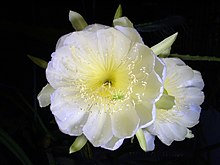Selenicereus megalanthus, synonym Hylocereus megalanthus,[1] is a cactus species in the genus Selenicereus that is native to northern South America, where it is known, along with its fruit, by the name of pitahaya. The species is grown commercially for its yellow fruit, but is also an impressive ornamental climbing vine with perhaps the largest flowers of all cacti.
The yellow fruit has thorns, unlike the red dragon fruits (e.g. S. undatus and S. monacanthus), and is commonly known as "yellow dragon fruit", "yellow pitahaya" or "yellow pitaya".
Etymology
Megalanthus (Greek) – large flowered. This species produces among of the largest flowers within the cactus family.
Origin and habitat
The species is native to Colombia, Costa Rica, Ecuador, Nicaragua, Panama, Peru, Trinidad and Tobago and Venezuela.[1] It is found in tropical riparian forests and is epiphytic or xerophytic.
Description
- Stems may lie along the ground (procumbent), climb (scandent), or hang (pendent). Stems are often only 1.5 cm thick, producing aerial roots; 3 ribs; margins slightly undulating; white areoles; 1-3 spines 2–3 mm long, yellowish; several hairs on young growth, brittle-like; green epidermis.
- Flowers are nocturnal and funnel-shaped, 32–38 cm long; pericarpel is ovoid or slightly globose, tubercles are large and flattened, with felt-like and spiny areoles subtended by small bracteoles; receptacle elongate; outer tepals long, green, triangular-acute; inner tepals 10 cm long, 3.5 cm wide, white, broader; stamens numerous inserted in two zones, yellow; style yellow, stigma lobes numerous, green.
- Fruit: ovoid, tuberculate, spiny, skin yellow (sometimes red/orange, when hybridized), seeds black; interior white (sometimes pink, when hybridized), edible, having a pleasant, mildly sweet flavor.
- Pollination: Yellow pitayas are self-fertile (meaning no cross-pollination is required)[2][3]
Cultivation
An easily cultivated, fast growing plant. Needs a compost containing plenty of humus and sufficient moisture in summer. Should not be kept under 8 °C (46.5 °F) in winter. Can be grown in semi-shade, but best in full sunlight. Extra light in the early spring will stimulate budding. Flowers in June to October. This plant may grow to a very large size.
| This article uses material from the Wikipedia article Metasyntactic variable, which is released under the Creative Commons Attribution-ShareAlike 3.0 Unported License. |


